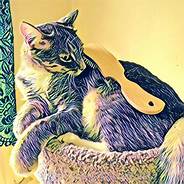Have you noticed that your cat has signs of dandruff — white, flaking, itchy skin? You might not realize that the problem is very common among cats. If your cat has this conditions, have you discovered the way to get rid of cat dandruff?
Possibly the problem proves to have a simple solution. If dry skin causes it, you may find you can help kitty easily, just be a small diet change or by using a humidifier. However, like any physical problem, whether yours or kitty’s, in order to cure it you must find the cause.
Do you know the difference between cat dandruff and cat dander? Cat dander involves the normal, healthy shedding of skin cells. Dandruff refers to the white flakes that gather on kitty, more numerous on the back and at the base of the tail.
Though dander often gets blamed for human allergies to cats, that is a misconception. The primary allergen for humans is found in cats’ saliva. The allergen becomes transferred to kitty’s fur and skin during grooming.
Dandruff has no relationship to the cat-human allergy reaction.
A Problem With Kittens
Dandruff can become a real problem with kittens, so check them regularly to make sure they have none.

You might find a simple solution to dandruff for cat or kitten. Possibly a regular brushing will take care of it. Turning on the humidifier could do it, if the problem simply has to do with the air becoming too dry.
More Severe Problems Are Possible
You might simply take the cat to the vet first, to determine the exact cause of the problem. It could be masking a more serious condition.
These can include parasites, such as mites, fleas, or lice, or an allergy of some kind. It could also indicate a metabolic disorder. These include diabetes and hyperthyroidism, which can impact kitty’s skin and fur.
If your kitty shows any of these signs, it is time for a trip to the vet to determine if kitty has any infection or other problem that requires medical attention:
- Cat appears to feel sick
- Skin thick and scaly, or having a rosy color
- Fur feels slick
- Coat is in poor condition overall, or shows signs of thinning
- Kitty grooms more frequently
- Kitty keeps scratching his itching skin
- Those tell-tale white flakes on skin, hair, or bedding
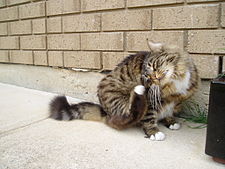
Causes Of Dandruff In Cats
You may find that dandruff occurs from any one of a number of causes. Look at this possible list:
1) Diet
You know, of course, that your cat needs a balanced diet, just as you do. Do you include omega fatty acids, like fish oil, in kitty’s diet? Make sure to feed your cat food that contains all the necessary nutrients, including omega 3.
An additional way to add healthy fatty acids consists of adding coconut or olive oil to kitty’s food. Check with your vet for proper dosage.
2) Dehydration
If your cat does not drink enough water, it could result in dry, flaking skin. He should drink around one ounce of water per pound of body weight each day.
If you can’t get your kitty to drink enough water, try these things:
a) Feed only wet food — no dry — as the wet food contains water.

b) Get a cat water fountain, as this may induce your cat to drink more.
Sometimes dehydration can occur because kitty finds the house too hot, or perhaps you live in a really hot climate. These conditions can lead to dandruff. Use a humidifier to combat this problem.
3) Obesity
When a cat struggles with weight, he becomes a likely candidate for dandruff. Because of his weight, he will not be able to fully groom himself. This problem can lead to skin issues. The cat may not be able to reach his back or the area around his tail.
As obesity can lead to diabetes, you can see the importance of keeping kitty’s weight at a healthy level. Otherwise, the diabetes becomes another potential cause of the dandruff.
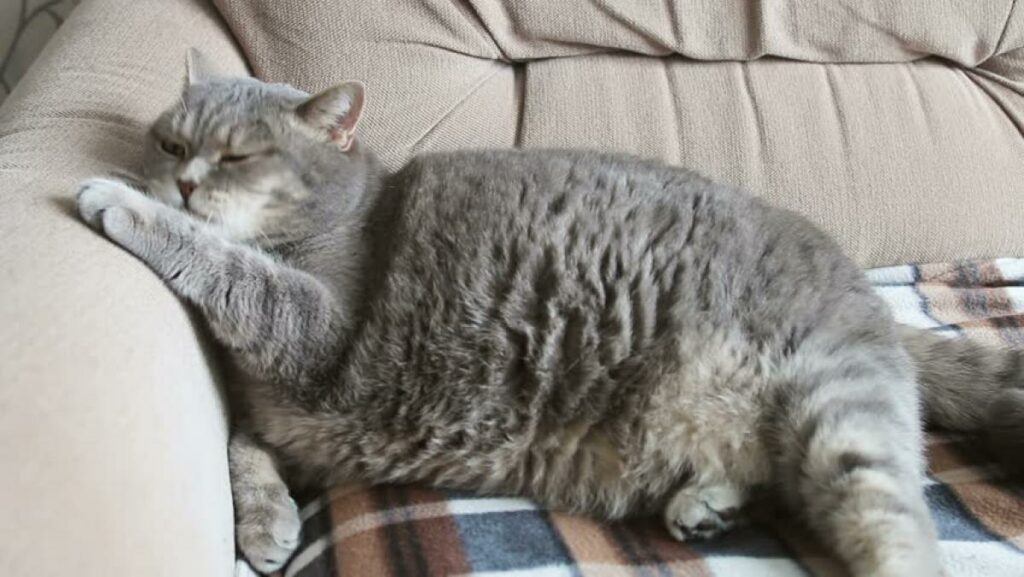
4) Old Age
The skin becomes dryer with age, and it loses its elasticity. The dry skin, accompanied by reduced blood flow, can lead to a greater susceptibility to a dandruff problem.
5) Allergies
a) Food: Did you change kitty’s food recently? Or, do you never change his food? Either of these might cause an allergic reaction. The new food may be missing some vital ingredients. Or, if always given the same food, changing it may eliminate the dandruff problem.
b) Environment: There may be something in the house that causes an allergic reaction in your cat. It may stem from plants, fertilizers, and even laundry detergent. Have you made any changes to the products you routinely use? These could cause the reaction. His allergies could also stem from dust mites, trees, or pollen.
My cat, Carlos, developed a strange allergy. First, he started losing fur from his tail. Then stomach fur started coming out, and the fur loss rose up his sides like a rising tide.
The only recent change I’d made in his diet: I’d started giving him Greenies to help clean his teeth. I stopped giving him the product, and his fur started growing back. Fortunately, he never developed dandruff.
6) Anxiety
Even stress can cause dandruff. If you make changes in your house, such as moving furniture, or adding a new family member, these can stress kitty. Remember, the cat establishes his routine and then expects it to remain unchanged.
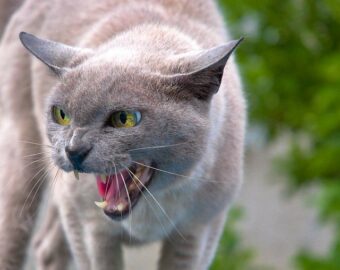
Give kitty extra love and attention during such changes, to help dispel his anxiety. Love and attention might solve the problem.
7) Sunburn
Cats can get sunburned just as we can. The more sensitive parts of their body, like nose, ears, mouth, and eyelids can present the biggest problem. Also, a kitty with light-colored fur might be more apt to sunburn. If you live in a very hot climate, make sure that you don’t let your cat spend too much time in the sun. It can cause the skin to peel and flake.
If sunburn causes your cat’s dandruff your vet may prescribe either an oil or a topical steroid.
Health Problems That Can Cause Dandruff
1) Feline Lymphoma
Feline lymphoma, one of the most common cancers in cats, basically represents cancer of the immune system. When this system becomes weakened, skin conditions such as dandruff may develop.
2) Fungal and Yeast Infections
These include ringworm and Malassezia dermatitis; these can all lead to hair loss.
Because cats can pass ringworm to humans, it becomes doubly important to rid kitty of this condition. In most animals, the round, hairless, itchy patches show up easily. However, some cats can be carriers of ringworm, causing this dermatophyte fungal infection to spread throughout their skin and hair but it does not cause solitary lesions.
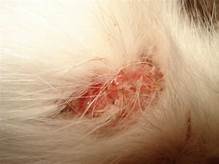
Ringworm relies on a fungal culture or a PCR test, done in a veterinary lab. If you think your kitty has ringworm, best get a test done at the vet’s and get it cleared up quickly, so you do not get it also.
3) Diabetes and Hyperthyroidism
These are metabolic disorders that can impact your cat’s skin and fur. These diseases will most likely appear in a middle-aged or older cat. Overweight cats or cats with some preexisting health condition are also at a higher risk for these diseases.
4) External Parasites
These can include fleas, lice, and mites. They irritate the cat’s skin and result in an allergic reaction, bringing on dandruff.
Serious dandruff can be a sign of a serious condition known as “walking dandruff.” Walking dandruff comes from the Cheyletiella mite, and causes a form of mange. If kitty develops this condition, get to a vet ASAP.
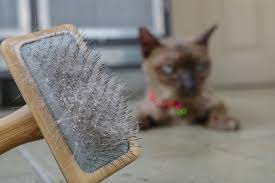
Diet And Grooming Recommended Treatments
1) Make sure your cat eats a balanced diet. You might add an omega-3 supplement designed specifically for cats.
2) Groom your cat gently two or three times each week. Remove loose hair and brush away mats, remembering to brush in the direction the hair grows.

3) Bathe him, but not too frequently. Use a medicated shampoo designed to keep the cat’s hair healthy. Never use human shampoo, as it will definitely aggravate the dandruff.
Just remember not to bathe the cat too often, or you can cause the skin to become dryer, creating more dandruff.
Remember These Things
Causes of dandruff can vary, so make sure you use the correct treatment. If you don’t know the best way to treat the problem, ask your vet.
Remember that your cat could require more fluids in their diet.
Feed natural meals, as these are most absorbable.
Use bathing if necessary, but be aware that kitty grooms herself as a matter of course. Do not interfere with this procedure.
Brush kitty at least twice a week.

Attempt to provide clean air, not polluted with cleaners or cigarette smoke.
Make sure kitty’s nutrition is excellent. He needs high-quality digestible proteins to regenerate those skin cells. Add omega 3 and 6. Vitamin A can also help maintain skin health.
Once you find out the cause of your cat’s dandruff, treatment should prove pretty easy. Be consistent and allow time for it to work. Of course, if the problem worsens instead of improving, it’s time to see the vet.
Your kitty’s comfort and health may well depend on your finding a solution for his problems.
References I used for this post:
thecatcare.org/cat purina.com/articles/cat/health/cat-dandruff veterinarians.org/cat-dandruff/

